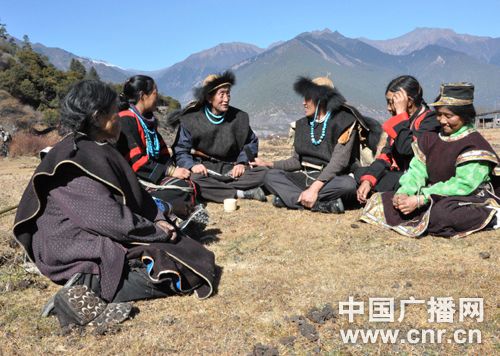
Yakshar(L 3), 82 year old Lhoba woman, is the inheritor of the epic of Wapa Taknyin, ancestor of Lhoba ethnic group, and the only bard who can recite the complete epic nowadays. [Photo/ China National Radio]
With financial and policy support from both the Central and local governments, the culture and tradition of Lhoba ethnic group who lives in China' Tibet is going to embrace a wave of revival.
Lhoba ethnic group has a small population of 3000 people, whose culture is endangered by the lack of written language and cultural inheritor.
When reporter from China Radio International entered Nanyi Lhoba Minzu (ethnicity) Village in Nyingchi Prefecture, the only ethnic village inhabited by Lhoba people, the 82 year old Lhoba woman Yakshar was sitting on the grassland, telling tales of Wapa Taknyin, ancestor of Lhoba people, word by word.
Even the elders could chant only some fragmental sentences from the tale, the young generation has no idea about it, said Yakshar, the inheritor of the epic of Wapa Taknyin and the only bard who can recite the complete epic.
The local residents believed that it was the profit contrast between the culture industry and tourism-oriented business which drove the labor force into sections such as tourism service, Cordyceps Sinensis trade, and even into other big cities.
A suit of Lhoba male attire would cost around 3000 rmb with labor-cost excluded, and take half a year to finish; on the contrary, the daily wage to work in other cities is 80 to 100 rmb, said a Lhoba people who stayed working in the village.
Jiang Xiaoping, deputy director of Culture Bureau of Mainling County, a county accommodates the most Lhoba ethnic communities in Nyingchi Prefecture, said that the local government was encouraging Lhoba people to protect their own cultural heritage through the way of developing cultural industry.
There would be more Lhoba people to participate in the protection work when they can earn more through culture industry than other occupations, and the culture of Lhoba ethnic group could be preserved better,said Jiang.
In order to preserve and spread the ethnic culture, the central and local governments, provinces and cities aiding Tibet, have invested a total amount of 1.6 million rmb to build training institutions and museums for the ethnic intangible heritages.
The launch of protective projects for ethnic tradition and culture has secured a list of cultural items too.
Mainling County has enlisted 16 county-level protective projects, 2 of which are listed as the National Intangible Heritage.
(Norbu Tsering and Sonam Dargye from China National Radio contributed to this report)
